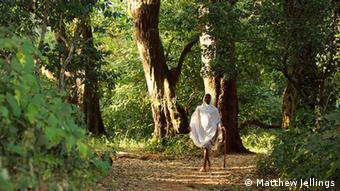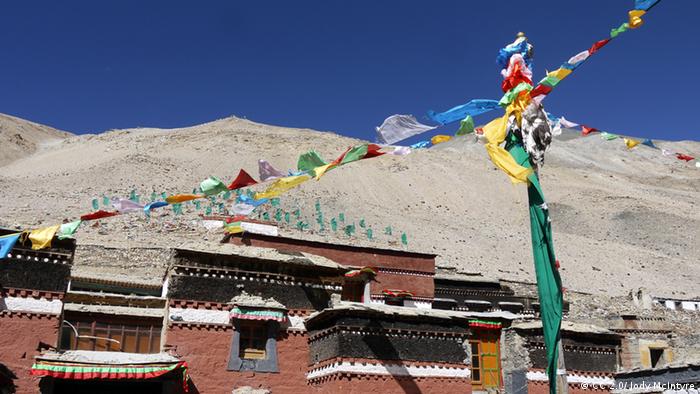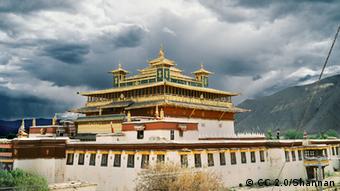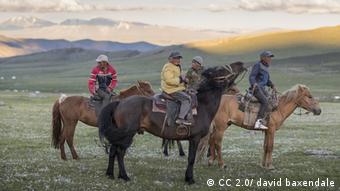- Date 16.09.2014
- Author Sonia Phalnikar
In a bid to protect the snow leopard, conservation groups are merging
western and traditional approaches by teaming up with local monasteries,
shamans and indigenous communities who live in the big cat’s habitat.
High up in the cold and rugged mountains of Pakistan, China, Tajikistan
and Afghanistan, a smoke-colored cat glides silently and almost
invisibly as it hunts blue sheep and ibex. The region's top predator,
the snow leopard, is not just notoriously elusive. It's also endangered
with likely fewer than 7,000 animals left in its vast range across
central and South Asia.
 As one of the top predators in the high mountain food chain of Central Asia, the snow leopard is considered an indicator species
Formal conservation programs focus on designating nature
reserves, fighting poaching and creating incentives for herders to
protect the snow leopard. But, recent research suggests that an unlikely
force has for a long time played a key role in contributing to the
cats’ survival - the Buddhist monastery, an influential institution in
nearly 80 percent of the snow leopard's global range spanning 12
countries.
As one of the top predators in the high mountain food chain of Central Asia, the snow leopard is considered an indicator species
Formal conservation programs focus on designating nature
reserves, fighting poaching and creating incentives for herders to
protect the snow leopard. But, recent research suggests that an unlikely
force has for a long time played a key role in contributing to the
cats’ survival - the Buddhist monastery, an influential institution in
nearly 80 percent of the snow leopard's global range spanning 12
countries.
Last year, a study of the big cat’s territory across the Tibetan Plateau found that the region's more than 300 Buddhist monasteries lie mostly within or near important snow leopard habitats. Carried out by Chinese researchers from Peking University, it focused on the Sanjiangyuan Nature Reserve in north-western China. About 2,000 - 4,000 snow leopards remain in China.
Monks critical to protecting cats
The research found that monasteries make for natural protective grounds with the snow leopard holding a special place in Tibetan Buddhism. “Each monastery is associated with a sacred mountain or forest that they protect,” Tom McCarthy, director of Snow Leopard Programs at the US-based Panthera conservation group who works closely with the Peking University team, says.
He adds that monks often organize patrols of their sacred landscapes to enforce strict Buddhist edicts concerning the reverence for all life. High-ranking monks or Rinpoches, also play a critical role in educating local communities about environmental protection. “It has a huge impact when senior Buddhist monks stand up during annual festivities and get local people to pledge not to kill wildlife,” McCarthy, says. “That helps preserve both the snow leopard's prey and habitat. But our associates at Peking University understand that monasteries in the region have been doing this for years.”
McCarthy says Panthera’s approach has been to supplement the traditional ecological knowledge of monasteries and local communities by training them in modern patrolling techniques and providing them with tools such camera traps to monitor wildlife. And, following last year’s study, Panthera also plans to start discussions in other snow leopard countries about including more monasteries in conservation programs.
The 'spiritual dimension' of conservation
Taking into account the religious and cultural beliefs of local communities and institutions to preserve species is an increasingly acceptable concept in conservation. In recent decades, an entire field of academic research has sprung up around the idea of strengthening connections between conservation and faith.
Biologists are turning to learn from the tradition, culture and ways of life of people who have, in some cases, lived for thousands of years on the very landscapes they seek to protect.
“Over the past ten years, we've seen more people in conservation being receptive to the spiritual dimension that nature has to people and which is, for example, evident in sacred natural sites,” Bas Verschuuren, co-Chair of the International Union for Conservation of Nature's (IUCN) Specialist Group on Cultural and Spiritual Values of Protected Areas, says.
”These places are some of the oldest protected areas in the world because they inform people's connection to nature and motivate them to revere and care for the environment,” he says.
Imagining a 'different' worldview
Sacred landscapes include groves, forests, mountains and valleys across places like the Himalayas, parts of Africa and Asia and the Andes. Often, they are home to ancient indigenous societies such as the Yanomami in the Brazilian Amazon, the Soliga and the Bishnoi in India or the Kalinga in the Philippines who have for centuries managed vast areas of biologically rich land.
 Formally educated scientists at times have a hard time grasping the
spiritual links that indigenous people have to their environment
At some of the sacred sites, tree felling or hunting are
prohibited; at others resource-use is strictly controlled while some
communities fiercely guard water bird nesting sites or fish reserves.
They often have detailed knowledge of the flora and fauna; to put it
simply, they know things we don’t.
Formally educated scientists at times have a hard time grasping the
spiritual links that indigenous people have to their environment
At some of the sacred sites, tree felling or hunting are
prohibited; at others resource-use is strictly controlled while some
communities fiercely guard water bird nesting sites or fish reserves.
They often have detailed knowledge of the flora and fauna; to put it
simply, they know things we don’t.
“Many of the cultural and spiritual values of sacred natural sites are intangible and mark people’s relationship with a space, plants, animals or nature, in general,” Netherlands-based Verschuuren, who has written widely on sacred sites, says.
“So it's easy to overlook if you're a western-educated conservation biologist or ecologist. It requires respect and willingness to look at the world through someone else's eyes and to imagine a worldview other than your own. That kind of thinking unfortunately doesn't come naturally to everyone,” he adds.
Shamans sit down with conservationists
But that is changing, especially in the isolated and harsh habitats of snow leopards where conservation groups are heavily reliant on local communities and their knowledge of the area.
The secretive snow-colored cat is the focus of several ancient traditions, legends and beliefs in many mountain regions. The animal is often considered a protector of sacred mountains, a unifying force and a source of spiritual power and wisdom. Some of the beliefs are part of religious rituals practised by indigenous healers and shamans in Kyrgyzstan, northern Nepal and the Altai mountains that stretch across Kazakhstan, Mongolia and Russia.
“In these places, the snow leopard is a mythical animal that constitutes a link between the spirit and the natural world of which humans are also a part,” Verschuuren, who has met with shamans from the spectacular Altai region, says. “It's drawn attention to the role of local shamans and traditional healers in these areas in preserving the habitat of the snow leopard.
In a way, their work over many generations has made them real and important conservationists in their own right,” he says, adding “you even have shamans being invited to the table to join conservation biologists and scientists to ensure the spiritual significance of the snow leopard becomes an integral part of their conservation.”
That was evident last year at a meeting in Kyrgyzstan of the 12 Asian snow leopard countries. For the first time it included input by local shamans and elders, giving them a direct voice in government level planning for protection of the wild cats.
It seems formally educated conservationists need no nudging to include traditional knowledge systems and insights when it comes to saving the snow leopard. And, that’s good news for the endangered big cat.
source
 As one of the top predators in the high mountain food chain of Central Asia, the snow leopard is considered an indicator species
As one of the top predators in the high mountain food chain of Central Asia, the snow leopard is considered an indicator speciesLast year, a study of the big cat’s territory across the Tibetan Plateau found that the region's more than 300 Buddhist monasteries lie mostly within or near important snow leopard habitats. Carried out by Chinese researchers from Peking University, it focused on the Sanjiangyuan Nature Reserve in north-western China. About 2,000 - 4,000 snow leopards remain in China.
Monks critical to protecting cats
The research found that monasteries make for natural protective grounds with the snow leopard holding a special place in Tibetan Buddhism. “Each monastery is associated with a sacred mountain or forest that they protect,” Tom McCarthy, director of Snow Leopard Programs at the US-based Panthera conservation group who works closely with the Peking University team, says.
He adds that monks often organize patrols of their sacred landscapes to enforce strict Buddhist edicts concerning the reverence for all life. High-ranking monks or Rinpoches, also play a critical role in educating local communities about environmental protection. “It has a huge impact when senior Buddhist monks stand up during annual festivities and get local people to pledge not to kill wildlife,” McCarthy, says. “That helps preserve both the snow leopard's prey and habitat. But our associates at Peking University understand that monasteries in the region have been doing this for years.”
McCarthy says Panthera’s approach has been to supplement the traditional ecological knowledge of monasteries and local communities by training them in modern patrolling techniques and providing them with tools such camera traps to monitor wildlife. And, following last year’s study, Panthera also plans to start discussions in other snow leopard countries about including more monasteries in conservation programs.
The 'spiritual dimension' of conservation
Taking into account the religious and cultural beliefs of local communities and institutions to preserve species is an increasingly acceptable concept in conservation. In recent decades, an entire field of academic research has sprung up around the idea of strengthening connections between conservation and faith.
Biologists are turning to learn from the tradition, culture and ways of life of people who have, in some cases, lived for thousands of years on the very landscapes they seek to protect.
“Over the past ten years, we've seen more people in conservation being receptive to the spiritual dimension that nature has to people and which is, for example, evident in sacred natural sites,” Bas Verschuuren, co-Chair of the International Union for Conservation of Nature's (IUCN) Specialist Group on Cultural and Spiritual Values of Protected Areas, says.
”These places are some of the oldest protected areas in the world because they inform people's connection to nature and motivate them to revere and care for the environment,” he says.
Imagining a 'different' worldview
Sacred landscapes include groves, forests, mountains and valleys across places like the Himalayas, parts of Africa and Asia and the Andes. Often, they are home to ancient indigenous societies such as the Yanomami in the Brazilian Amazon, the Soliga and the Bishnoi in India or the Kalinga in the Philippines who have for centuries managed vast areas of biologically rich land.
 Formally educated scientists at times have a hard time grasping the
spiritual links that indigenous people have to their environment
Formally educated scientists at times have a hard time grasping the
spiritual links that indigenous people have to their environment “Many of the cultural and spiritual values of sacred natural sites are intangible and mark people’s relationship with a space, plants, animals or nature, in general,” Netherlands-based Verschuuren, who has written widely on sacred sites, says.
“So it's easy to overlook if you're a western-educated conservation biologist or ecologist. It requires respect and willingness to look at the world through someone else's eyes and to imagine a worldview other than your own. That kind of thinking unfortunately doesn't come naturally to everyone,” he adds.
Shamans sit down with conservationists
But that is changing, especially in the isolated and harsh habitats of snow leopards where conservation groups are heavily reliant on local communities and their knowledge of the area.
The secretive snow-colored cat is the focus of several ancient traditions, legends and beliefs in many mountain regions. The animal is often considered a protector of sacred mountains, a unifying force and a source of spiritual power and wisdom. Some of the beliefs are part of religious rituals practised by indigenous healers and shamans in Kyrgyzstan, northern Nepal and the Altai mountains that stretch across Kazakhstan, Mongolia and Russia.
“In these places, the snow leopard is a mythical animal that constitutes a link between the spirit and the natural world of which humans are also a part,” Verschuuren, who has met with shamans from the spectacular Altai region, says. “It's drawn attention to the role of local shamans and traditional healers in these areas in preserving the habitat of the snow leopard.
In a way, their work over many generations has made them real and important conservationists in their own right,” he says, adding “you even have shamans being invited to the table to join conservation biologists and scientists to ensure the spiritual significance of the snow leopard becomes an integral part of their conservation.”
That was evident last year at a meeting in Kyrgyzstan of the 12 Asian snow leopard countries. For the first time it included input by local shamans and elders, giving them a direct voice in government level planning for protection of the wild cats.
It seems formally educated conservationists need no nudging to include traditional knowledge systems and insights when it comes to saving the snow leopard. And, that’s good news for the endangered big cat.
source



No comments:
Post a Comment